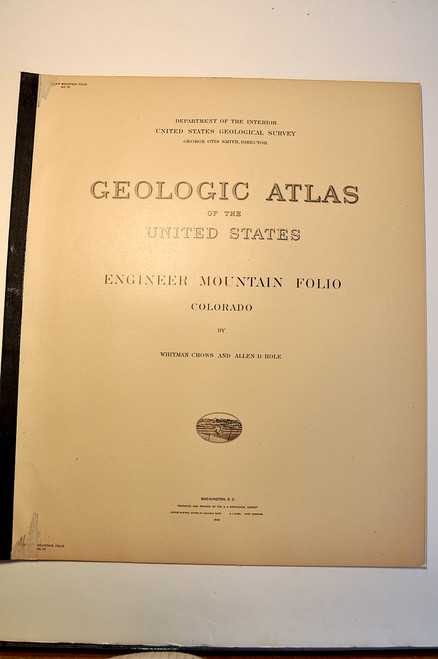Hague, James D. & Clarence King; Mining Industry. With Geological Contributions by Clarence King. United States Geological Exploration of the Fortieth Parallel, Clarence King, Geologist-in-Charge. Submitted to the Chief of Engineers and Published by Order of the Secretary of War under Authority of Congress. Washington, GPO, 1870. Quarto text, folio atlas. Text, pp. 10, xii, 4, 647, 3, frontispiece, 37 plates, some folding. Atlas, 14 plates (most colored, some double page).
The set is complete with the text in a green library cloth with gilt spine titles and catalogue number. The binding is tight and clean, the text and plates are bright and free of foxing and stains. Stamp of the University of Idaho on title page and text block edge with penned signature of original owner on edge of title. The atlas is in the original calf and cloth with gilt cover titles. The binding is tight and clean, all plates are exceptionally bright and clean. Over all a very good complete set.
Clarence King (1842-1901) studied geology at Yale, served as a volunteer on Josiah Dwight Whitney's (1819-1896) Geological Survey of California, and directed the Fortieth Parallel Survey (1867-1872) from the Rocky Mountains to the the Sierra Nevada, topographically and geologically mapping some 100,000 square miles. He established a framework for orogenic history of the American Cordillera that has remained unchanged and recognized what we know today as the Sonoma, Sevier, and Laramide orogenies. He noted that folding of Paleozoic strata in the Great Basin recorded east-west crustal shortening and delineated trends of Laramide folds. King rejected Lyell’s uniformitarianism and tied Darwinian evolution to episodes of natural selection to natural catastrophes. Above all else, King’s work proved that many of the major advances in the geological sciences in the second half of the 1800s came about due to the larger systematic organization of geological work Geological studies could not be confined within State lines or other artificial boundaries. The aid of the federally funded government and systematical surveys covering vast areas were proven to provide the best over all results for both science and industry. King recognized the broadest approach to studying geology across arbitrarily set state and territorial boundaries. He also recognized and accepted the public demand for a direct application of the results of government geological work. While King wanted all aspects of geology covered in his surveys, he directed that a special study be made of the developed and newly developed mining districts of the West. Particular attention was paid to the Comstock Lode, at that time recognized as one of the greatest silver deposits in the world. With the aid of his close friend and geologist Arnold Hague (1840-1917), the results of this survey was pushed rapidly to completion and was published in 1870 in a beautifully illustrated quarto volume and folio atlas under the title of "Mining Industry." It was described in a review: "itself a scientific manual of American precious metal mining and metallurgy." It was considered a classic among works in mining geology, and has served as a model for similar monographs since published under government auspices. Above all else it was an important factor in having both the mining industry of America and the general public accept the role of federally funded geological surveys in America. That led to the establishment of the USGS in 1879 with King as its first Director. King was to immediately appoint Arnold Hague to the survey. King accepted the appointment to head the USGS with the understanding that he should remain at its head only long enough to appoint its staff, organize its work, and guide it into full activity. Under his direction were carried on the examinations of the Comstock, Eureka, Leadville, and other mining districts, whose importance is to be measured not solely by the accurate information which was published on each particular region, but in far greater degree by their influence upon the whole body of mining engineers, in teaching them the practical importance of an accurate study of the geological relations of ore deposits.
The “Mining District” text and atlas provide a broad overview of mining districts in the west, a more detailed look at the Comstock Lode and Washoe District, its geology, structural geology, the structure and mode of occurrence of the major ore body, and details on the various mines, the methods of exploiting the ores, the cost and yield, treatment of the ores, the various machinery used in the crushing, amalgamation and milling processes. The various classes of ores are deceased and the chemistry of the “Washoe process”.Other districts in central, eastern and western Nevada are discussed. The geology of the Toyabe Range, Reese River, White Pine District, Egan Canon District, and Green River coal basin are discussed. The work then moves to Colorado and its geology followed by discussions of gold mining in Colorado, the Gilpin gold veins, silver mining in Colorado and the Georgetown silver ores.
The beautifully detailed and colored atlas is mostly on the Comstock Lode with an additional map of the Toiyabe Mountains and the White Pine District. This is also the first such map atlas devoted to a major mining district in the US.

















